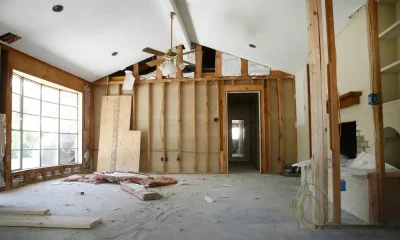Renovation
Property Enhancement And Safety: A Homeowner’s Guide To DIY

Enhancing one’s property is a journey most homeowners undertake at some point, driven by the desire to improve aesthetics, functionality, or value.
Embarking on do-it-yourself (DIY) projects can be fulfilling and cost-effective. However, it’s essential to prioritize safety while achieving these enhancements.
This guide delves into the critical aspects of property enhancement and safety, providing practical advice for homeowners eager to take on DIY projects.
By focusing on safety-first practices, homeowners can ensure their property improvements are not only successful but also conducted in a secure and responsible manner.
Safety First In DIY Projects
Safety is the cornerstone of any successful DIY project.
While the allure of transforming spaces and creating something with your own hands is strong, it’s vital to approach these tasks with a safety-first mindset.
This approach involves understanding the risks associated with different projects, using the right tools, and wearing appropriate safety gear.
Being prepared and aware can significantly reduce the likelihood of accidents and injuries, ensuring a smoother and more enjoyable DIY experience.
Wearing Safety Glasses
One of the most crucial safety measures in DIY projects is wearing safety glasses.
These are not just for professional construction workers; they are an essential piece of personal protective equipment for anyone engaging in home improvement tasks.
Safety glasses provide a barrier against a myriad of potential hazards, from flying debris and dust to accidental splashes of harmful chemicals.
They come in various styles and types, including those with prescription lenses, ensuring that every DIY enthusiast can find a pair that suits their needs.
Remember, protecting your eyes is not just about avoiding immediate injuries; it’s also about safeguarding your long-term vision health.
Whether you’re sawing wood, drilling holes, or even just hammering nails, wearing safety glasses is a simple yet effective step towards a safer DIY experience.
Proper Handling Of Tools And Equipment
The right tools can make a DIY project easier and more efficient, but they can also pose risks if not handled properly.
Safety in tool usage starts with selecting the right tool for the job and understanding its operation.
Always read the manufacturer’s instructions before using any new tool. Regular maintenance, such as sharpening blades and checking cords for damage, is crucial.
When using power tools, be mindful of your surroundings, keeping the work area free of clutter and ensuring that you have a stable stance.
Unplug tools when not in use and store them safely out of reach of children. Remember, respect for your tools is a respect for your own safety.
Electrical Safety Measures
Electrical projects, whether it’s installing a new light fixture or replacing an outlet, require special attention to safety.
Before starting any electrical work, always turn off the power at the circuit breaker. Use a voltage tester to ensure that the power is indeed off.
Be cautious of water and damp environments when working with electricity, as they can increase the risk of shock.
Wear rubber-soled shoes and use tools with insulated handles to minimize risks.
If you’re not confident about your electrical skills or the project is complex, consider hiring a professional.
Electrical safety is not just about avoiding immediate hazards; it’s also about ensuring that the work done doesn’t pose any future risks to your home.
Common Challenges In DIY Home Improvements: Statistics and Insights
Embarking on DIY home improvement projects can be an exciting endeavor, but it’s not without its challenges.
Here’s an overview of common issues faced by homeowners, supported by relevant statistics:
Budget Overruns
A significant number of homeowners (80%) reported going over their initial budget by at least $500 when undertaking home improvement projects.
High Participation With Varied Success
In recent times, the DIY trend has seen a surge, with 60% of people starting a DIY home improvement project in 2022.
However, not all these attempts are successful; four in 10 people report more failures than successes in their DIY endeavors.
Injury Risks
DIY projects are not without risk. In 2020, there were 24,534 home improvement injuries requiring hospital admission, with lacerations being the most common injury leading to ER visits (127,486 visits).
The majority of these injuries occur to the fingers, a prevalent injury site given the nature of most home improvement tasks.
Abandonment And Professional Intervention
Nearly half of the individuals (45%) in a survey admitted to completely botching a home improvement project, leading to an average of five hours of trial and error before calling a professional for help.
The conclusion you can draw is it indicates a high rate of project abandonment due to complications or unsatisfactory progress.
Dependency On Professional Help
Despite the popularity of DIY, a majority of Americans still resort to seeking professional help (38%), significant others (37%), or friends (24%) for assistance in home improvement projects.
Dependency often arises from the complexity of tasks and the need for specialized skills.
Social Media Influence
The influence of social media is evident, with many DIY enthusiasts attempting to replicate projects they see online.
Room remodeling (32%), furniture building (28%), and pool-cleaning (23%) are popular projects inspired by social media.
However, the kitchen, a common focus of remodeling, is cited as the most challenging room to renovate, with nearly a third (29%) of DIYers facing roadblocks
Sustainable And Eco-Friendly Improvements
One of the most impactful ways to enhance your home is by focusing on energy efficiency.
This not only benefits the environment but can also lead to significant cost savings.
Consider replacing old appliances with energy-efficient models, which use less electricity and water.
Installing programmable thermostats allows for better control of heating and cooling, reducing energy consumption when the home is unoccupied.
Simple acts like sealing windows and doors can also improve energy efficiency by minimizing drafts.
Utilizing Renewable Energy Sources
Incorporating renewable energy sources is a forward-thinking approach to home improvement.
Solar panels are increasingly accessible and can significantly reduce electricity bills while lowering carbon footprints.
For those unable to install panels, opting for green energy plans from your utility provider can be an alternative.
Additionally, consider installing solar-powered outdoor lighting for an eco-friendly and aesthetic addition to your outdoor spaces.
Water Conservation Practices
Water conservation is an essential aspect of sustainable living. Installing low-flow showerheads and dual-flush toilets can drastically reduce water usage.
In gardens, opt for drought-resistant plants and consider setting up a rainwater harvesting system for irrigation.
These measures not only save water but also reduce your utility bills.
Final Remarks
Enhancing your home through DIY projects can be an exciting and rewarding endeavor. Focusing on safety first ensures that these projects are carried out without compromising personal well-being.
From wearing safety glasses to handling tools properly and being mindful of electrical safety, these practices are essential for a secure DIY experience.
enhancing the aesthetics and functionality of your home brings personal satisfaction and can increase its value.
Implementing sustainable and eco-friendly improvements also contributes positively to the environment and can lead to long-term cost savings.
Remember, the key to successful home improvement lies in planning, safety, and a balance of aesthetics, functionality, and sustainability.
Whether you’re a seasoned DIY enthusiast or a beginner, these guidelines can help transform your home improvement journey into a safe, enjoyable, and fulfilling experience.






